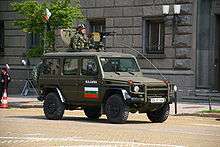Balkan Battlegroup
| EU Balkan Battlegroup HELBROC | |
|---|---|
 BG Emblem | |
| Active | 1 July 2007– present |
| Country |
|
| Allegiance |
|
| Branch | EU Battlegroup |
| Type | Regiment |
| Part of | European Union Military Staff |
The Balkan Battlegroup is a EU Battlegroup led by Greece. Originally referred to as HELBROC (an acronym for HELlas, Bulgaria, ROmania, Cyprus), it consists of military units from Greece, Bulgaria, Romania, and Cyprus. During its third and fourth standby period in the second half of 2011 and 2014, the Balkan Battlegroup was joined by Ukraine.[1][2]
History
The Balkan Battlegroup has been on standby in the following semesters:
- 1 July – 31 December 2007.[3]
- 1 January – 30 June 2009.[3]
- 1 July – 31 December 2011 (including Ukraine).[1]
- 1 July – 31 December 2014 (including Ukraine).[1][2]
It is expected to serve again in 2016, 2018 and 2020.[2]
On 1 July 2011, Ukraine was part of the Balkan Battlegroup for the first time. It contributed 10 staff officers, a company of Ukrainian armoured vehicles manned with marines, and an Ilyushin Il-76 strategic lift aircraft.[1] Even with the War in Donbass going on since April 2014, Ukraine took part in the Battlegroup's standby period in the second half of 2014.[2] The Riga Declaration of 22 May 2015 stated that the Eastern Partnership Summit's participants 'appreciate Ukraine's contribution to an EU Battlegroup in 2014 and its interest in continuing such contributions in the future'.[4] Anders Åslund, Senior Fellow of the Atlantic Council, was highly critical of the "embarrassing" EU declaration, that did not explicitly condemn Russia's actions in Ukraine, and only summarily praised Ukraine's contribution to the EU Battlegroup, commenting that: "Ukraine offers the EU admittedly minor military support, while the EU does nothing for Ukraine."[5]
On 8 November 2016, Serbia, an EU candidate state, signed an agreement to become part of the Battlegroup,[6] bringing the number of member countries to six.
Emblem
The emblem shows a white pigeon which carries an olive branch to the burning globe, on a canvas of the EU flag. The participating nations’ flags are seated on the top of the emblem, in the same order as they appear in HELBROC BG initials.
The olive branch and the pigeon are the very ancient symbols of peace and in combination with the burning globe reflect the urgent intervention of the HELBRROC BG, whenever may be required.

Exercises
To complement HELBROC's operational training, two exercises were conducted in May 2007. The first was Command Post Exercise (CPX) EVROPI – I and the second was LIVe Exercise (LIVEX) EVROPI – II.
References
- 1 2 3 4 Leigh Turner (11 July 2011). "Ukraine joins EU battle group". Foreign Office blogs. Foreign and Commonwealth Office. Retrieved 12 July 2015.
- 1 2 3 4 Nestoras, Antonios (19 May 2015). The Common Security and Defence Policy: National Perspectives. Academia Press. p. 62. ISBN 9038225245. Retrieved 12 July 2015.
- 1 2 Volpi, Valerio (2011). Why Europe Will Not Run the 21st Century: Reflections on the Need for a New European Federation. Cambridge: Cambridge Scholars Publishing. p. 155. ISBN 1443830526. Retrieved 12 July 2015.
- ↑ "Joint Declaration of the Eastern Partnership summit (Riga, 21-22 May 2015)". European Council. 22 May 2015. Retrieved 12 July 2015.
- ↑ Anders Åslund (26 May 2015). "The Disastrous EU Summit on the European Partnership". Atlantic Council website. Atlantic Council. Retrieved 12 July 2015.
- ↑ "Serbia joins EU's HELBROC battlegroup". Tanjug. 8 November 2016. Retrieved 10 November 2016.
